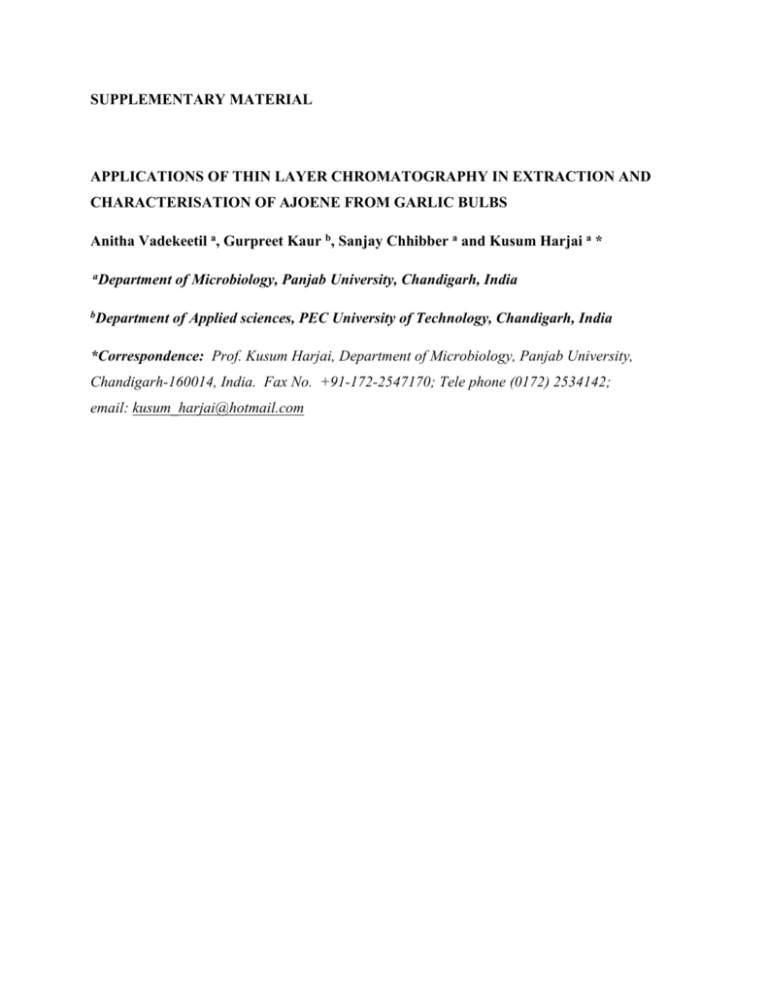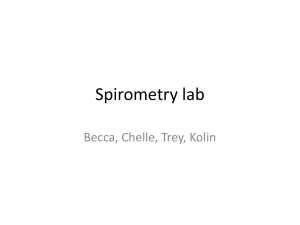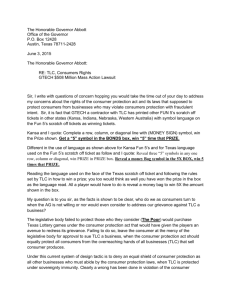Figures - Figshare
advertisement

SUPPLEMENTARY MATERIAL APPLICATIONS OF THIN LAYER CHROMATOGRAPHY IN EXTRACTION AND CHARACTERISATION OF AJOENE FROM GARLIC BULBS Anitha Vadekeetil a, Gurpreet Kaur b, Sanjay Chhibber a and Kusum Harjai a * aDepartment of Microbiology, Panjab University, Chandigarh, India bDepartment of Applied sciences, PEC University of Technology, Chandigarh, India *Correspondence: Prof. Kusum Harjai, Department of Microbiology, Panjab University, Chandigarh-160014, India. Fax No. +91-172-2547170; Tele phone (0172) 2534142; email: kusum_harjai@hotmail.com Abstract Novel and inexpensive methods of thin layer chromatography (TLC) was employed for the extraction, characterisation and mechanism of quorum sensing inhibition (QSI) by ajoene, a component from toluene garlic bulb (Allium sativum L.) extract (TGE). TLC profiling of TGE was carried out using ethyl acetate as solvent. Out of total spots extracted from TLC, four spots exhibited QSI potential. Among those, spot 5 was identified as Z-ajoene by TLC and confirmed by NMR and MS. HPLC analysis indicated 97.7% purity for purified ajoene. TLC densitometric analysis quantified 221.08 µmol/g of ajoene in TGE and indicated ajoene is stable at 4°C and at acidic pH. HP-TLC profiling showed that ajoene exhibits QSI effect by inhibiting the production of both long chain acyl homoserine lactones (AHLs) and Pseudomonas quinolone signal (PQS) by P.aeruginosa and also by inactivating PQS molecules. Keywords: Thin layer chromatography; Ajoene; Quorum sensing inhibition; Pseudomonas aeruginosa; Experimental Bacterial strains Standard strain of P. aeruginosa PAO1 maintained on nutrient agar slants and stabs and stored at 4°C. Reporter strains Escherichia coli MG4 (pKDT17) and biosensor Agrobacterium tumefaciens A136 (pCF218, pCF372) was maintained on Luria Bertani agar slants containing ampicillin (100 μg/ml) for the former and tetracycline (4.5 μg/ml), spectinomycin (50 μg/ml) for the latter strain. Glycerol stocks were prepared and stored at -70°C. Fresh stocks were subcultured for every new experiment. Plant material Garlic bulbs (Allium sativum L., desi variety) were procured from agricultural fields near Kharar, Panjab, India. Voucher specimens were identified by Dr. Sunita Garg, chief scientist, RHMD, CSIR-NISCAIR, Delhi, India and deposited in the herbarium of raw material herbarium and museum (RHMD), Delhi, India with Ref No. NISCAIR/RHMD/Consult/2014/2430/9. Preparative Thin layer chromatography of TGE TGE was prepared as per the standard method (Rasmussen, Bjarnsholt, Skindersoe, Hentzer, Kristoffersen & Kote, 2005) and stored at -20°C. The concentrate was dissolved in toluene and spotted on Silica 60 F254 TLC plates (Merck). The chromatogram was developed using HPLC grade ethyl acetate as mobile phase. TLC fingerprint was then visualized under UV 254 nm. Spots were physically separated by scraping bands from the plate after complete drying of the solvent. It was then re-chromatographed two times and extracted with HPLC grade ethyl acetate and concentrated. Bioassay guided fractionation of TLC spots The TLC extracted concentrated spots were assessed for quorum sensing inhibition by putting up qualitative assay with reporter strain E.coli MG4. Sterile whatmann No.1 filter paper discs were impregnated with TLC extracted spots (2mg/10µl of ethyl acetate) and incubated in luria agar plates spreaded with X-gal, concentrated AHL and E.coli MG4 reporter. Ethyl acetate disc was kept as negative control. Diameter of colourless zone around each disc was measured. Identification and characterisation of QSI spot TLC Purified QSI spot was co-chromatographed with the standard ajoene (EZ mixture of ajoene, provided by Inqpharm SDN BHD, Malaysia) using HPLC grade ethyl acetate as developing solvent and visualized under UV 254 nm. Rf value of QSI spot was measured and compared with that of standard ajoene. HPLC Purified QSI spot and standard ajoene were analysed by analytical high performance liquid chromatography (HPLC system 1525) using C18 column (150*4.6mm). The eluent was acetonitrile:water (80:20) at a flow rate of 0.9 ml/min. The eluate was monitored for its purity as well as identity at 254nm in the UV detector. NMR and MS 1 H NMR spectra of the purified QSI spot were measured using Bruker Avance II 400 NMR spectrophotometer. Chemical shifts were recorded at 400 MHz using DMSO-d6 as solvent. Mass spectrum was analysed using Waters Q-TOF Micromass using leucine as an internal standard. Quantification of ajoene in TGE Preparation of calibration curve Ajoene in TGE was quantified using HPTLC densitometric method. Different volumes of (2, 4 and 6µl) standard ajoene of concentrations 50 and 100 µg/ml were spotted on TLC Si 60 F 254 plate (20*10 cm, Merck) in triplicates using CAMAG automatic TLC sample applicator fitted with a microlitre syringe. The plate was developed till 90 mm in CAMAG twin-trough development chamber using HPLC grade ethyl acetate as mobile phase. Using CAMAG UV cabinet, the plate was visualized at a wavelength of 254nm. All the tracks were scanned using CAMAG scanner 3 and using Wincats integration software, peak area was calculated. By plotting spot density (nmol) versus area of band, calibration curve was prepared (Bala, Gupta, Chhibber & Harjai, 2013). Quantification of ajoene TGE concentrate (1mg/ml) of volumes 4µl and 6µl was spotted in triplicates along with standard ajoene and developed in similar way as mentioned above. The peak area was calculated and amount of ajoene in TGE concentrate was calculated from calibration curve. Rf values and absorption spectra of ajoene in TGE concentrate was compared to reconfirm the spot as ajoene. Assessment of stability of ajoene Effect of physical conditions on abundance of ajoene TGE was treated at temperature of 37°C and 4°C (at constant pH of 7) and at pH of 2, 4 and 9 at constant temperature of 37°C for 24 hours. Samples of volume 5 µl were spotted on TLC plate in triplicates and developed using ethyl acetate. Ajoene in TGE was quantified using regression equation from calibration curve. Effect of physical conditions on activity of ajoene Effect on acyl homoserine lactone molecules (AHLs): Standard strain of P. aeruginosa PAO1 was allowed to grow in absence and presence of purified ajoene (2.5mg/ml, concentration that did not affect growth of the organism) for 24 hours at 37°C. The supernatant was extracted twice with acidified ethyl acetate. Synthetic AHL mixture (C6, C10 and C12, 50 µM) was also incubated with purified ajoene at 37°C for 3 hour, 8 hour and 24 hours. 10 µl of these samples was spotted on C18 RP TLC plates (10*10 cm, Merck, Germany) along with synthetic AHL mixture and was allowed to develop till 90 mm using methanol: water (6:4) as eluent. It was air dried and overlayed with 0.8 % agar containing biosensor strain Agrobacterium tumefaciens A136, X-gal (80 µg/ml) and respective antibiotics. It was incubated for 48 hours at 30°C and observed for blue coloration (Kumar, Gupta, Chhibber & Harjai, 2013). Effect of ajoene on Pseudomonas quinolone molecules (PQS): TLC plate (Si 60 F 254, Merck) was activated with 5% KH2PO4 (w/v) for half an hour and heated at 100°C for 1 hour was used. P. aeruginosa was grown in presence and absence of ajoene (2.5mg/ml, concentration that did not affect growth of the organism) and ethyl acetate extract of cell free supernatant was prepared as mentioned above. Synthetic PQS (100 µM) was incubated with purified natural ajoene at 37°C for 24 hours. 10 µl of both the samples were spotted on activated TLC plate along with 10 µl of synthetic PQS (Sigma) and was developed using dichloromethane: methanol (95:5) as mobile phase. After drying the TLC plate, it was visualized under CAMAG scanner 3 at wavelength of 366 nm and PQS was quantified using regression equation from calibration curve of standard PQS (Bala, Gupta, Chhibber & Harjai, 2013). Figures Figure S1: TLC fingerprint of TGE concentrate visualized under UV 254 nm using CAMAG scanner 3 Figure S2: QSI effect of TLC fractionated spots (2-6) and negative control ethyl acetate (Et). Bioassay was carried out on luria agar plate spread with X-gal, concentrated AHL and reporter strain E.coli MG4. The diameter of colorless zone around each disc impregnated with respective spot was measured as QSI index Figure S3a: Identification of spot 5 using TLC: lane 1: TGE concentrate (50mg/ml); lane 2: standard ajoene (mixture of EZ ajoene, 5mg/ml); lane 3: standard ajoene (1 mg/ml); lane 4: standard ajoene (250µg/ml); lane 5: TLC purified spot 5. Rf of standard and spot 5 was found to be 0.68. Figure S3b: (1) HPLC profile of standard ajoene (EZ isomeric mixture) (2) HPLC profile of TLC purified spot. The samples were run in WATERS 1525 HPLC system using a mobile phase of acetonitrile:water (80:20). A sharp peak of ajoene was obtained at Rt of 4.189 min for standard ajoene and 4.225 min for TLC purified ajoene. Figure S3c: 1H NMR spectra and assigned structure of TLC purified spot 5. Figure S3d: ESI-MS (+) spectra of TLC purified spot 5. Figure S3e: (1) Representative peak of standard ajoene (100 µg/ml) on HPTLC showing Rf value of 0.68. (2) Calibration curve of standard ajoene calculated from HP-TLC densitometric analysis Figure S4a: Effect of purified ajoene on AHL molecules: TLC plate (C18 RP Si) overlayed with biosensor Agrobacterium tumefaciens A136. Lane 1: synthetic AHL mixture (C6, C10 and C12); lane 2: ethyl acetate extract of P. aeruginosa PAO1 grown in presence of ajoene at 37°C, neutral pH; lane 3: synthetic AHL mixture treated with ajoene at 37°C for 24 hours; lane 4: synthetic AHL mixture treated with ajoene at 37°C for 3 hour, lane 5: synthetic AHL mixture treated with ajoene at 37°C for 8 hour Figure S4b: Effect of purified natural ajoene on PQS molecule: TLC plate visualized under UV 366nm: lane 1-2-synthetic PQS; lane 3-4-ethylacetate extract of P. aeruginosa PAO1 at 37°C for 24 hours; lane 5-6 – ethyl acetate extract of P. aeruginosa PAO1 grown in presence of ajoene at 37°C for 24 hours; lane 7-8-synthetic PQS treated with ajoene at 37°C for 24 hours Table S1 TLC-densitometric analysis showing effect of physical conditions on the amount of natural ajoene in toluene extract of garlic Sr. No. Physical conditions Amount of ajoene (nmol/mg of TGE) 1. 4°C, pH 7.0 221.06 2. 37°C, pH 2.0 144.19 3. 37°C,pH 4.0 138.3 4. 37°C, pH 9.0 48.852 5. 37°C,pH 7.0 28.516 References Bala, A., Gupta, R.K., Chhibber, S., & Harjai, K. (2013). Detection and quantification of quinolone signaling molecule: a third quorum sensing molecule of Pseudomonas aeruginosa by high performance-thin layer chromatography. Journal of Chromatography B, 930, 30-35. Kumar, L., Gupta, R.K., Chhibber, S., & Harjai, K. (2013). Optimisation of growth conditions and purification of quorum sensing molecules produced by Pseudomonas aeruginosa. International Journal of Pharmaceutical and Biological Science, 4, 507-514. Rasmussen, T.B., Bjarnsholt, M.E., Skindersoe, M., Hentzer, P., Kristoffersen, M., & Kote, J. (2005). Screening for quorum-sensing inhibitors (QSI) by use of a novel genetic system, the QSI selector. Journal of Bacteriology, 187, 1799-1814.







